-
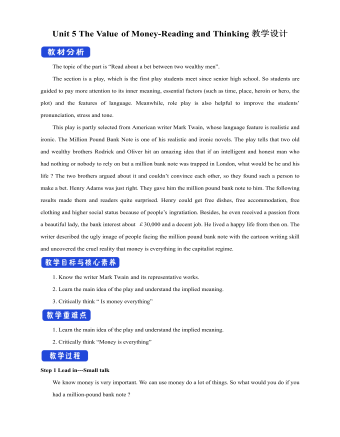
新人教版高中英语必修3Unit 5 The Value of Money-Reading and Thinking教学设计一
Everybody wants to get wealth.In today’s material world,making money or becoming wealthy symbolizes a person’s success and capability. Many people just make every effort, pay any price to attain greater wealth. With money,they can buy nice, large apartments in nice neighborhood. With money they can own luxurious cars. Wealth seems to bring all happiness in life.But is wealth the only road to happiness? Not really. There are many things in the world, which are beyond the means of money, such as friendship, love, health and knowledge. People are so preoccupied with struggling for money that they have no time or would not take the time to form or maintain friendship. What happiness can they feel living as lonely miserable creatures without love or friends in the world even if they accumulate tremendous wealth?In my opinion, people can’t do anything without money, but money is not everything. What money will bring you depends on your personal belief and goal in life. If you are kind enough to help others, especially the poor, money is a good thing to you. With it, you can do much more for the benefit of people and your country, and it will add to your own happiness. If you want money just for your own needs, you’ll never be satisfied or happy. In a word,you should have money spent for more people. Only then can money be the source of your happiness.Step 8 Homework4 students in a group, one acts Roderick, one Oliver, one servant and the fourth one acts Henry Adams, then listen to the tape, pay more attention to the difference between American English and British English in pronunciation, stress, tone.

新人教版高中英语必修3Unit 5 The Value of Money-Reading for Writing教学设计二
2. 您能看到, 我头发太长了。You can see that my hair is much too long.3. 无论什么时候, 只要您想回来就回来。Please come back whenever you want.4. 您仅有很少的头发要理! You only have too little hair to cut !5. 为您服务是我的荣幸!It is my honour to serve you!Step 9 Writing(Henry is walking down the street when he sees a sign for a place that cuts hair. He decides to have it cut. )H=Henry B=BarberH: Good afternoon, I’d like to have my hair cut, if I may. (The barber looks at Henry’s hair and continues cutting another man’s hair. ) Er, I’d really like a haircut. As you can see it’s much too long. B: (in a rude manner) Yes, I can see that. Indeed, I can. H: Fine, well, I’ll have a seat then. (He sits in one of the barber’s chairs. The barber turns to look at Henry. )B: It’s quite expensive here, you know! Are you sure you can afford it?H: Yes. I think so. (After his hair is cut, the barber tells Henry how much he must pay. Henry shows the barber the bank note. )B: Why Mr. . . (looks shocked)H: Adams. Henry Adams. I’m sorry. I don’t have any change. B: Please don’t worry! (wearing a big smile) Nothing to worry about! Nothing at all! Please come back whenever you want, even if you only have too little hair to cut! It will be my honour to serve you!Step 10 Pair workExchange drafts with a partner. Use this checklist to help your partner revise his/her draft.1. Are all the elements of a play included and in good order ?2. Do the character use suitable language ?3. Are the stage directions clear and useful ?4. Is the plot clear and exciting enough ?

新人教版高中英语必修3Unit 5 the value of money-Reading For Writing教学设计一
【参考范文】Narrator:(Henry is smiling as he leaves the restaurant. As he is walking down the street, he sees a sign for a place that cuts hair. He decides to get it cut. )H=Henry;B=Barber;R=rude manH:Good afternoon, I'd like to get a cut, if I may. (The barber looks at Henry's hair and continues cutting another man's hair. )Er, I'd really like a haircut. As you can see it's much too long. B:(in a rude manner) Yes, I can see that. Indeed, I can. H:Fine, well I'll have a seat then. (He sits in one of the barber's chairs. The barber turns to look at Henry. )B:It's quite expensive here, you know!Are you sure you can afford it?H:Yes. I think so. (In comes the rude man. )R:Hey you there. I need a haircut quickly. Can you do me straightaway?B:All right, then, get in the chair and I'll see what I can do. R:Thank you. (sits down in one of the barber's chairs)H:Excuse me, but I was here first. Aren't you going to do my hair first?B:This man's in a hurry. H:Well so am I!I insist that you cut my hair first. B:OK, but I'll have to be quick. This gentleman is waiting. H:Thank you. (They both become quiet. After his hair is cut, the barber tells Henry how much he must pay. Henry shows the barber the bank note. )B:Why, Mr . . . (looks shocked)H:Adams. Henry Adams. I'm sorry, I don't have any change. R:You're that Mr Adams! Well,I'm glad I waited or I might never have known it was you. B:Why, Mr Adams, please don't worry!(wearing a big smile) Nothing to worry about!Nothing at all!Please come back any time, even if you only need too little hairs cut!It will be my honour to serve you!

新人教版高中英语选修2Unit 4 Journey Across a Vast Land教学设计
当孩子们由父母陪同时,他们才被允许进入这个运动场。3.过去分词(短语)作状语时的几种特殊情况(1)过去分词(短语)在句中作时间、条件、原因、让步状语时,相当于对应的时间、条件、原因及让步状语从句。Seen from the top of the mountain (=When it is seen from the top of the mountain), the whole town looks more beautiful.从山顶上看,整个城市看起来更美了。Given ten more minutes (=If we are given ten more minutes), we will finish the work perfectly.如果多给十分钟,我们会完美地完成这项工作。Greatly touched by his words (=Because she was greatly touched by his words), she was full of tears.由于被他的话深深地感动,她满眼泪花。Warned of the storm (=Though they were warned of the storm), the farmers were still working on the farm.尽管被警告了风暴的到来,但农民们仍在农场干活。(2)过去分词(短语)在句中作伴随、方式等状语时,可改为句子的并列谓语或改为并列分句。The teacher came into the room, followed by two students (=and was followed by two students).后面跟着两个学生,老师走进了房间。He spent the whole afternoon, accompanied by his mom(=and was accompanied by his mom).他由母亲陪着度过了一整个下午。

新人教版高中英语选修2Unit 2 Bridging Cultures-Discovering useful structures教学设计
The grammar of this unit is designed to review noun clauses. Sentences that use nouns in a sentence are called noun clauses. Nominal clauses can act as subject, object, predicate, appositive and other components in compound sentences. According to the above-mentioned different grammatical functions, nominal clauses are divided into subject clause, object clause, predicate clause and appositive clause. In this unit, we will review the three kinds of nominal clauses. Appositive clauses are not required to be mastered in the optional compulsory stage, so they are not involved.1. Guide the students to judge the compound sentences and determine the composition of the clauses in the sentence.2. Instruct students to try to learn grammar by generalizing grammar rules, controlling written practice, and semi-open oral output.3. Inspire the students to systematize the function and usage of noun clause1.Instruct students to try to learn grammar by generalizing grammar rules, controlling written practice, and semi-open oral output.2.Inspire the students to systematize the function and usage of noun clauseStep1: The teacher ask studetns to find out more nominal clauses from the reading passage and udnerline the nominal clauses.

新人教版高中英语选修2Unit 3 Food and Culture-Discovering useful structures教学设计
The newspaper reported more than 100 people had been killed in the thunderstorm.报纸报道说有一百多人在暴风雨中丧生。(2)before、when、by the time、until、after、once等引导的时间状语从句的谓语是一般过去时,以及by、before后面接过去的时间时,主句动作发生在从句的动作或过去的时间之前且表示被动时,要用过去完成时的被动语态。By the time my brother was 10, he had been sent to Italy.我弟弟10岁前就已经被送到意大利了。Tons of rice had been produced by the end of last month. 到上月底已生产了好几吨大米。(3) It was the first/second/last ... time that ...句中that引导的定语从句中,主语与谓语构成被动关系时,要用过去完成时的被动语态。It was the first time that I had seen the night fact to face in one and a half years. 这是我一年半以来第一次亲眼目睹夜晚的景色。(4)在虚拟语气中,条件句表示与过去事实相反,且主语与谓语构成被动关系时,要用过去完成时的被动语态。If I had been instructed by him earlier, I would have finished the task.如果我早一点得到他的指示,我早就完成这项任务了。If I had hurried, I wouldn't have missed the train.如果我快点的话,我就不会误了火车。If you had been at the party, you would have met him. 如果你去了晚会,你就会见到他的。

新人教版高中英语选修2Unit 3 Food and Culture-Reading and thinking教学设计
The discourse explores the link between food and culture from a foreign’s perspective and it records some authentic Chinese food and illustrates the cultural meaning, gerography features and historic tradition that the food reflects. It is aimed to lead students to understand and think about the connection between food and culture. While teaching, the teacher should instruct students to find out the writing order and the writer’s experieces and feelings towards Chinese food and culture.1.Guide the students to read the text, sort out the information and dig out the topic.2.Understand the cultural connotation, regional characteristics and historical tradition of Chinese cuisine3.Understand and explore the relationship between food and people's personality4.Guide the students to use the cohesive words in the text5.Lead students to accurately grasp the real meaning of the information and improve the overall understanding ability by understanding the implied meaning behind the text.1. Enable the Ss to understand the structure and the writing style of the passage well.2. Lead the Ss to understand and think further about the connection between food and geography and local character traits.Step1: Prediction before reading. Before you read, look at the title, and the picture. What do you think this article is about?keys:It is about various culture and cuisine about a place or some countries.

新人教版高中英语选修2Unit 5 First Aid-Discovering useful structures教学设计
You have no excuse for not going.你没有理由不去。He was punished for not having finished his homework.他因未完成作业而受到惩罚。2.动词ing形式复合结构由物主代词或人称代词宾格、名词所有格或普通格加动词ing,即“sb./sb.'s+doing”构成。动词ing形式的复合结构实际上是给动词ing形式加了一个逻辑主语。动词ing形式的复合结构有四种形式:①形容词性物主代词+动词ing②名词所有格+动词ing③代词宾格+动词ing④名词+动词ingHer coming to help encouraged all of us.她来帮忙鼓舞了我们所有人。The baby was made awake by the door suddenly shutting.这个婴儿被突然的关门声吵醒了。Can you imagine him/Jack cooking at home?你能想象他/杰克在家做饭的样子吗?无生命名词无论是作主语还是作宾语都不能用第②种形式。Tom's winning first prize last year impressed me a lot.汤姆去年得了一等奖使我印象深刻。Do you mind my/me/Jack's/Jack leaving now?你介意我/杰克现在离开吗?Excuse me for my not coming on time.很抱歉我没能按时来。His father's being ill made him worried.他父亲病了,他很担心。We are looking forward to the singer's/the singer to give us a concert.我们盼望着这位歌手来给我们举办一场演唱会。
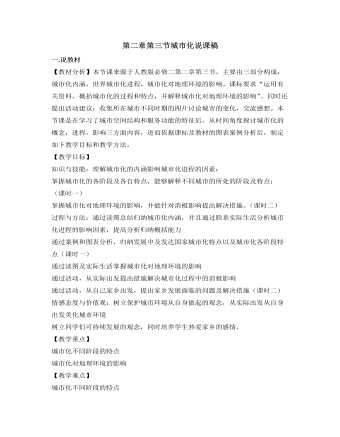
人教版高中地理必修2第二章第三节城市化说课稿
投影上海市的卫星城镇建设、交通改善图以及住房图等,探讨上海为解决城市化的问题做了哪些方面的工作?进一步引导思考总结对于城市化带来的问题,除了上海市的做法,你还有什么想法?◆设计意图:借上海的例子一方面引导学生解决问题的思路,让学生自己掌握城市化问题及措施,活跃思维;另一方面帮助学生树立学习优秀的意识;4.活动设计.未来展望——生态城市课本38页的活动,结合合肥市环城公园,解释生态城市。◆设计意图:进一步让学生认识到人地协调的重要性,牢固树立可持续发展的观念。5.活动设计分析南京的城市化过程中存在哪些问题,除了共性外,还有没有自己的个性问题?对于问题展开讨论,并提出相应的解决措施。◆设计意图:结合身边的地理,落实乡土地理的教育,激发学生热爱家乡,从身边的环境小事做起,落实环境教育。
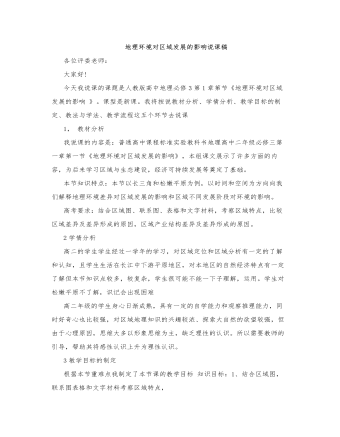
人教版高中地理必修3地理环境对区域发展的影响说课稿
本节课我分成两个课时A首先我会在在ppt上放几张关于区域的图,让学生思考什么是区域,区域有什么特征。其次我会在在书上画出区域的定义,在给与解释说明,再在书上画出区域的四个特征,让同学小组讨论哪些区域是有界的,哪些区域是无界的,从而加深同学们对区域的理解。B在ppt上放出长江三角洲和松嫩平原,不同风土人情由此导入下一个知识点:不同区域由于地理环境的差异,人们的生产特点有许多的不同,发展方式也存在差异,然后让学生思考长江三角洲和松嫩平原有什么差异,各自给区域环境发展带来什么影响,启发学生从气候等方向思考,然后用表格的方式给不同因素归类(归位自然和社会经济两大类)再启发同学们从两大类分别讨论对农业与工业发展的影响,最后再用表格的形式分类表达C然后给同学们几个问题,巩固同学课堂所学,最后留下一个问题课后解决:除了今天讲的因素外还有哪些因素对区域发展产生影响?
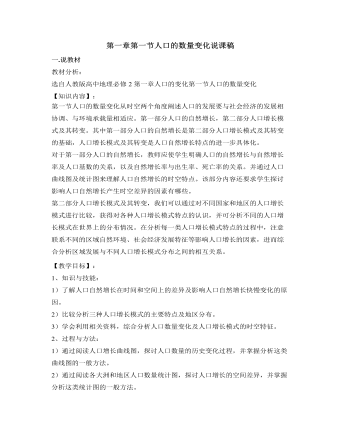
人教版高中地理必修2第一章第一节人口的数量变化说课稿
活动一:课本第三页的活动题,把学生分成几组然后让他们读图讨论,思考书上的几个问题,最后派个代表回答问题.最后教师做适当的补充:人口的自然增长不仅与人口自然增长率有关,而且还与人口基数有关.活动二:课本第七页的活动,先让两位学生阅读第六页的案例结合活动题思考问题,让几个组学生讨论所给的几个问题.让学生归纳最后教师做适当的补充.时间安排:由于本节内容不难因此整个教学过程是一节课的时间来完成的因此在教学过程中注意时间的把握,在做活动和讨论时注意把握时间,自己尽量少说废话.课堂小结通过这一节的学习,同学们正确理解和认识人口增长,增长模式和人口增长模式的转变。我们可以利用比较法、分析法来掌握,并联系现实生活,进行分析、判断,化理论知识于实践之中。
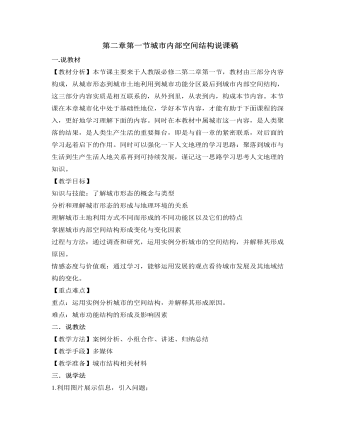
人教版高中地理必修2第二章第一节城市内部空间结构说课稿
提问:结合课本找出城市地域结构模式的类型及各自特点,模式形成的因素又有哪些?学生回答,使其掌握基本模式及特点,通过对比,分析把握每一模式各自的特征,学会把握事物本质。◆设计意图:阅读课本,总结归纳,同时引导,通过原因规律的探究,大胆设想,总结规律掌握人文地理学习思路。4.活动设计:内部空间结构变化,结合实例,分析说明。提问:结合江宁区的变化,分析江宁区城市结构发生了哪些变化?结合课本24页活动题,提出功能结构布局方案?通过理论联系实际,让学生更好理解理论,掌握城市结构布局的变化及其影响因素,通过活动题方案的提出,学生能够掌握布局的规律性,解决问题。设计意图:理论联系实际,知识的不枯燥性,提高学生学习兴趣。同时,能够通过总结,深层次认识城市结构布局,活学活用。
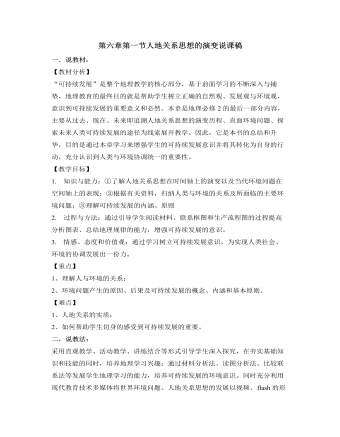
人教版高中地理必修2第六章第一节人地关系思想的演变说课稿
四、说教学过程:1、导入新课:以视频形式导入新课,说明环境问题产生原因,引出人地关系的重要性2、新课讲授:学习主题一:过去——人地关系的历史回顾以动画形式展现人地关系思想的发展,激发学生学习本专题的兴趣,归纳人与自然关系的演变过程。学习主题二:现状——直面环境问题以人类与环境关系模式图说明环境问题产生的原因,人地关系实质;以因果联系框图培养学生判读方法,了解人口、资源与环境三者之间的关系;通过阅读课文,了解环境问题的类型及其空间差异的表现;以图表了解不同国家和地区环境问题在空间轴上的表现;以《京都议定书》为引子说明保护环境是全人类的共同使命学习主题三:未来——可持续发展展示“可持续发展示意图”理解可持续发展内涵、原则
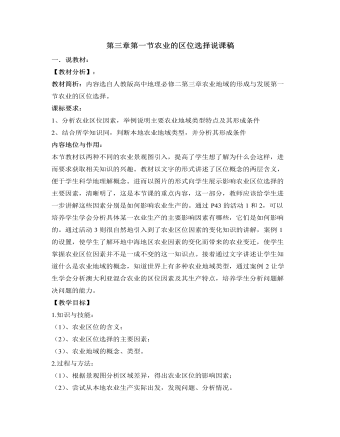
人教版高中地理必修2第三章第一节农业的区位选择说课稿
◆设计意图:培养学生独立思考、合作学习的能力。分别说明市场、交通、劳动力、机械和政策对农业生产的影响,让学生切实地考虑,拓展学生思路。教师激发和维持学生学习动机、引导学生、帮助学生自主发现、探索知识,达到巩固所学知识,检验学生的实践应用能力。D.分析教材,识别图片,理解农业地域阅读、分析教材,看图识别,研究案例《澳大利亚地混合农业生产》、思考问题、解决问题◆设计意图:图片展示能清楚直观地说明问题,通过案例分析,了解澳大利亚的混合农业生产,培养学生独立思考问题、解决问题的能力,开拓学生思路。3.课堂小结:◆设计意图:帮助学生回顾课堂、巩固所学知识。4.反馈练习:◆设计意图:知识与能力强化训练,巩固本课所学知识,提高应用能力。
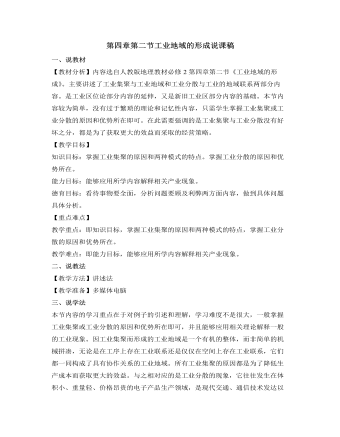
人教版高中地理必修2第四章第二节工业地域的形成说课稿
下面要针对工业地域内部的工业联系进行讲解,这里主要涉及到的是工序上的工业联系。在这段文字的处理上,我会将钢铁、石化、机械加工等工业部门分散成一步一步的工序,便于学生理解这种工业上的联系方式与构造,进而对于工业的发育程度这一概念的理解也就相对简单了。紧接着需要讲述的是工业分散的内容。工业分散是建立在现代的交通运输方式和通信技术与手段上的。它主要针对的是体积小、重量轻、价格昂贵的电子产品生产领域,目的是根据原件的不同性质选择不同的生产地域,利用其各异的优势条件以节省开支。由于案例都是针对高科技产品的生产而提出的,因此在这段教材的教学中我会注意避免将工业分散这一现象描述得更为高级。要让学生明白,无论是工业集聚还是工业分散,它们之间是没有好坏之分的。最后将进行课堂小结,由于本节内容较少且相对简单,可以在最后适当添加部分练习题,重点考察一二两节的相关知识点。
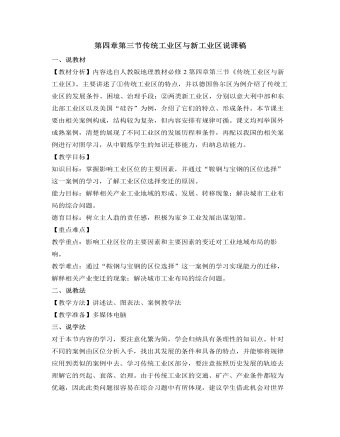
人教版高中地理必修2第四章第三节传统工业区与新工业区说课稿
下面是对以高技术产业为主的新工业区的内容进行讲解,教材以美国“硅谷”为例,首先谈的是高技术工业的特点,然后讲述的是“硅谷”的发展条件,由于教学模式与意大利新工业区的内容基本一致,这里就不再赘述了。接下来教材中提到的与之对照的案例同样是以高技术产业而闻名的中关村,由于中关村在国内的知名度较高,一般学生都有所了解,因此不妨让学生谈谈自己的看法:对于高新技术产业的发展有何建议,相对于发展较为成功的“硅谷”我们需要学习的方面又是哪些?案例中最后一个问题很值得深省,我国的新工业区到底怎样做才能够获得成功,简单的模仿下我们缺少的又是什么?这个问题可以作为拓展,让学生写一篇简短的论文作为课后作业。最后做以简单的课堂小结。本节内容的教学可能会相对繁杂,而案例之间的分析过程又过于雷同,所以难免枯燥。在处理这个问题上,我将尽量做到详略得当,主要培养学生的自主学习能力。
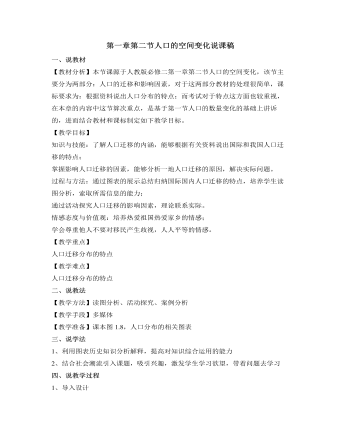
人教版高中地理必修2第一章第二节人口的空间变化说课稿
一、说教材【教材分析】本节课源于人教版必修二第一章第二节人口的空间变化,该节主要分为两部分:人口的迁移和影响因素,对于这两部分教材的处理很简单,课标要求为:根据资料说出人口分布的特点;而考试对于特点这方面也较重视,在本章的内容中这节算次重点,是基于第一节人口的数量变化的基础上讲诉的,进而结合教材和课标制定如下教学目标。【教学目标】知识与技能:了解人口迁移的内涵,能够根据有关资料说出国际和我国人口迁移的特点;掌握影响人口迁移的因素,能够分析一地人口迁移的原因,解决实际问题。过程与方法:通过图表的展示总结归纳国际国内人口迁移的特点,培养学生读图分析,索取所需信息的能力;通过活动探究人口迁移的影响因素,理论联系实际。情感态度与价值观:培养热爱祖国热爱家乡的情感;学会尊重他人不要对移民产生歧视,人人平等的情感。【教学重点】人口迁移分布的特点

人教版高中地理必修2第一章第三节人口的合理容量说课稿
【教学目标】知识与技能:理解环境承载力与环境人口容量的含义、两者的关系以及环境人口容量的影响因素;理解人口合理容量的含义,影响因素并掌握保持人口合理容量的做法;结合中国国情提出适合中国保持合理人口容量的措施过程与方法:通过问题探究及案例分析理解环境承载力与环境人口容量的关系及影响因素;通过问题探讨掌握保持人口合理容量的措施。情感态度与价值观:树立并强化学生的可持续发展观念,科学发展观。激发学生爱国情感更多地关注国家国情,树立主人翁意识保护地球强大祖国。【教学重点】环境人口容量的内涵以及影响因素人口合理容量的影响因素以及措施【教学难点】环境人口容量的内涵以及影响因素人口合理容量的影响因素以及措施二、说教法【教学方法】案例分析、问题探究、归纳总结
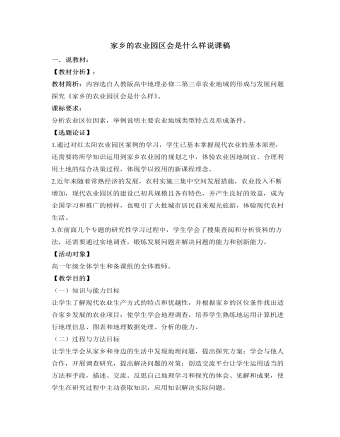
人教版高中地理必修2家乡的农业园区会是什么样说课稿
第三阶段:分班交流论证,归纳整理成文在学生分组搜集整理资料的基础之上,我们又以班级为单位由核心组成员组织资料交流并展开讨论,共同归纳整理,集体完成《常熟建设现代农业科技园区可行性分析调查表》中的相关内容,交给各自的指导老师修改。第四阶段:分片走进园区,体验总结反思我们本着“熟悉家乡、就近考察”的原则把全年级的学生分成八组,分别到八个园区开展实地调查。组织他们听园区领导或专业人员介绍园区的建设情况和远景规划,深入田间地头和温室大棚参观园区生产装备和农民劳动场景,开展园区劳动体验,与园区农民交谈等系列活动。要求大家在体验劳动、收获快乐的同时,对照《常熟现代化农业园区建设和发展情况调查表》的内容逐一展开讨论并认真填写。在此基础上,我们又要求各片的同学认真反思每个园区在发展过程中还有哪些不够完美的地方和需要改进的建议。
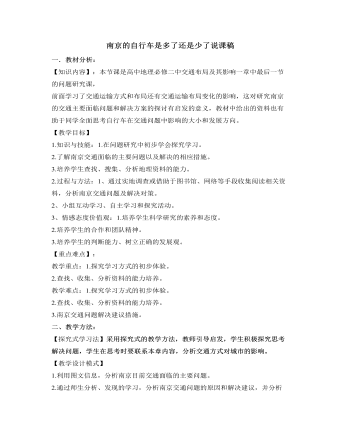
人教版高中地理必修2南京的自行车是多了还是少了说课稿
在学生回答的基础上进行归纳小结:发展城市公共交通? 明确道路分工? 合理规划停车场? 减少出行距离? 错开出行高峰? 加大城市道路建设? 进行科学合理的交通管理,重视智能交通系统的建设提问:这组同学在幻灯片中提到城市环境污染源主要有哪些?城市交通环境问题除了交通工具的尾气排放带来大气污染外,还会给城市环境带来什么问题?这组同学基本同意自行车多是加剧南京空气污染的间接原因,你同意他们的观点吗?在学生回答的基础上,教师进行归纳小结:自行车是一种绿色交通工具,既环保又经济。只有当它在某些机动车和非机动车不分的地段,影响车辆行驶速度的时候,它才可能成为加剧空气污染的间接原因。那么我们针对交通工具对环境造成的影响,除了这组同学提到的三点解决措施以外,我们还有什么要补充的解决方法吗?

